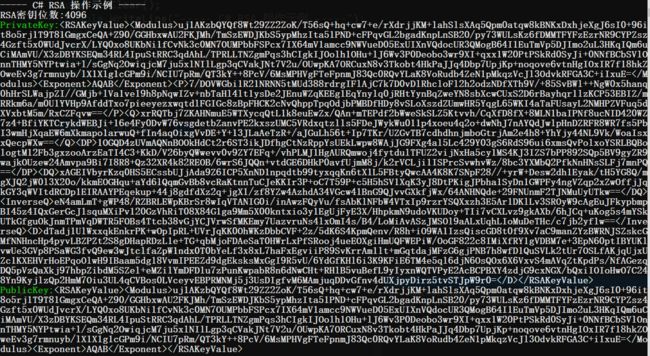RSA介绍
RSA公钥加密算法是1977年由Ron Rivest、Adi Shamirh和LenAdleman在(美国麻省理工学院)开发的。RSA取名来自开发他们三者的名字。
RSA的缺点:
-
产生密钥很麻烦,受到素数产生技术的限制,因而难以做到一次一密。
-
分组长度太大,为保证安全性,n 至少也要 600bits以上,使运算代价很高,尤其是速度较慢,较对称密码算法慢几个数量级;且随着大数分解技术的发展,这个长度还在增加,不利于数据格式的标准化。目前,SET(Secure Electronic Transaction)协议中要求CA采用2048bits长的密钥,其他实体使用1024比特的密钥。C)RSA密钥长度随着保密级别提高,增加很快。下表列出了对同一安全级别所对应的密钥长度。
保密级别 对称密钥长度(bit) RSA密钥长度(bit) ECC密钥长度(bit) 保密年限 80 80 1024 160 2010 112 112 2048 224 2030 128 128 3072 256 2040 192 192 7680 384 2080 256 256 15360 512 2120
C#中RSA的相关操作
- 生成公钥和私钥
struct RSASecretKey
{
public RSASecretKey(string privateKey, string publicKey)
{
PrivateKey = privateKey;
PublicKey = publicKey;
}
public string PublicKey { get; set; }
public string PrivateKey { get; set; }
public override string ToString()
{
return string.Format(
"PrivateKey: {0}\r\nPublicKey: {1}", PrivateKey, PublicKey);
}
}
///
/// generate RSA secret key
///
/// the size of the key,must from 384 bits to 16384 bits in increments of 8
/// - 实现公钥加密私钥解密
string RSAEncrypt(string xmlPublicKey,string content)
{
string encryptedContent = string.Empty;
using(RSACryptoServiceProvider rsa = new RSACryptoServiceProvider())
{
rsa.FromXmlString(xmlPublicKey);
byte[] encryptedData = rsa.Encrypt(Encoding.Default.GetBytes(content), false);
encryptedContent = Convert.ToBase64String(encryptedData);
}
return encryptedContent;
}
string RSADecrypt(string xmlPrivateKey, string content)
{
string decryptedContent = string.Empty;
using (RSACryptoServiceProvider rsa = new RSACryptoServiceProvider())
{
rsa.FromXmlString(xmlPrivateKey);
byte[] decryptedData = rsa.Decrypt(Convert.FromBase64String(content), false);
decryptedContent = Encoding.GetEncoding("gb2312").GetString(decryptedData);
}
return decryptedContent;
}
密钥格式的转换
C#中RSA公钥和私钥的格式都是XML的,而在其他语言如java中,生成的RSA密钥就是普通的Base64字符串,所以需要将C#xml格式的密钥转换成普通的Base64字符串,同时也要实现Base64密钥字符串生成C#中xml格式的密钥.
安装 BouncyCastle 这个Nuget包PM > Install-Package BouncyCastle
BouncyCastle项目网址
BouncyCastlegithub地址
构造一个RSAKeyConventer类
namespace RSA
{
using System;
using System.Security.Cryptography;
using Org.BouncyCastle.Asn1.Pkcs;
using Org.BouncyCastle.Math;
using Org.BouncyCastle.Pkcs;
using Org.BouncyCastle.Asn1.X509;
using Org.BouncyCastle.X509;
using Org.BouncyCastle.Security;
using Org.BouncyCastle.Crypto.Parameters;
public class RSAKeyConverter
{
///
/// xml private key -> base64 private key string
///
///
///
/// xml public key -> base64 public key string
///
///
///
/// base64 private key string -> xml private key
///
///
///
/// base64 public key string -> xml public key
///
///
/// 

